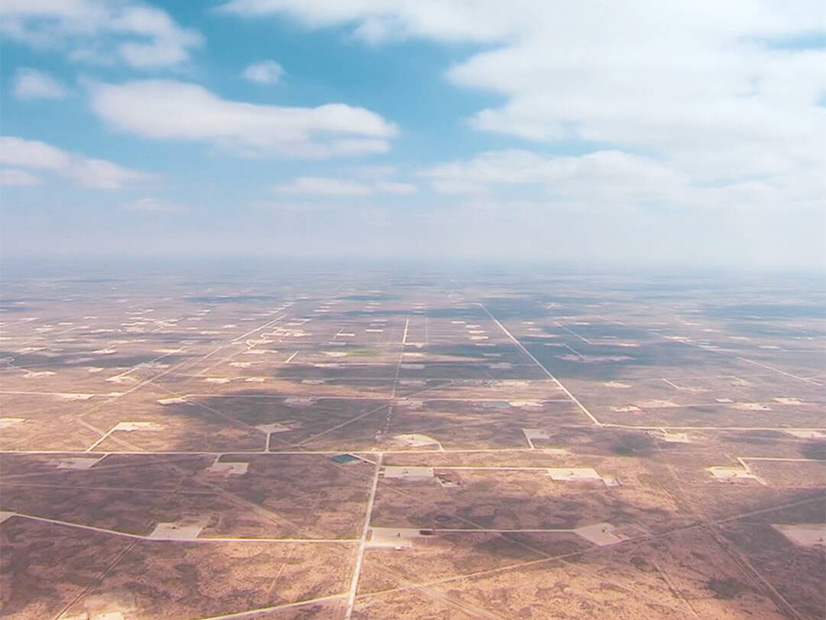
ERCOT told Texas regulators its initial reliability study of the Permian Basin indicates “substantial amounts” of transmission projects will be needed to meet its projected load by 2038.
ERCOT told Texas regulators their initial reliability study of the Permian Basin, the nation’s largest oil production field, indicates “substantial amounts” of local transmission projects are needed to meet the 24 GW of load projected to be added by 2038.
During the Public Utility Commission’s open meeting April 11, the grid operator’s Kristi Hobbs said it will have to add about 565 circuit miles of new 345-kV lines, eight new 345/138-kV substations with 18 new 345/138-kV transformers and about 344 miles of new 138-kV lines. ERCOT also needs to upgrade about 326 miles of existing 345-kV lines (55718).
None of that includes “significant” regional upgrades needed to transfer power across the ERCOT system. The grid operator said it will begin identifying import paths into the Permian.
“There is not a lot of generation within the Permian Basin region to serve all the additional load that is being forecasted,” Hobbs, vice president of system planning and weatherization, told the commissioners. “We will continue looking at revising the plan for the local region as well as coming to you … for what is going to be needed for imports across the state into the region.”
Hobbs said 58% of the nearly 12 GW of expected non-oil and gas load is composed of crypto mining facilities. Green hydrogen represents 22% of the coming load, with commercial industrials accounting for 12% and data centers 8%.
“This is just one example of what we’re going to continue to see throughout the rest of the state as we look at reliability plans,” Commissioner Lori Cobos said.
The PUC last year directed ERCOT to develop a reliability plan for the Permian Basin, a response to legislation passed earlier in 2023 to address the region’s rapidly increasing demand for power. The commission prioritized the plan’s development as it addresses the state’s population and economic growth.
Saying he senses ERCOT conducts its various modeling studies in silos, Commissioner Jimmy Glotfelty asked Hobbs whether staff could combine some of that analysis.
“I think this will have an impact on inverter-based resources [in the Permian],” he said. “It will have [an] impact on what we can import to that area and export out of that area, and I just think we need to have a better picture with all of those things modeled together.”
Hobbs said one of ERCOT’s key goals is evolving the transmission planning process. Staff already are studying 765-kV transmission lines and their integration into the grid. Hobbs promised a report will be delivered to the commission this summer.
“We’re moving on a fast timeline,” she said. “We recognize the tremendous load growth on the system. We also recognize that the types of resources that are being added to this system are not the traditional resources that we want to plan for. We are looking at ways that we can continue to evolve the process to meet the needs for the fast-growing state.”
The Permian Basin encompasses 66 counties in southeastern New Mexico and western Texas. It produces nearly 40% of the nation’s oil and roughly 15% of its natural gas, according to the Federal Reserve Bank of Dallas.
Other Business
In other actions during the open meeting, the PUC approved a 150-MW El Paso Electric (EPE) solar facility (54929) and Xcel Energy subsidiary Southwestern Public Service’s (SPS) rate case (54634).
EPE’s Texas Solar One is composed of two components: a 50-MW portion the utility plans to dedicate to a voluntary subscription program and a 100-MW portion to serve retail customers. Under an agreement with the city of El Paso, the Office of Public Utility Counsel and Texas Industrial Energy Consumers, EPE will place a capital cost cap on the facility and add a performance guarantee and a commitment to credit its customers with 100% of Texas Solar One’s production tax credits.
The commission signed off on an unopposed agreement between SPS and various parties that provides for a $65 million increase in the utility’s Texas retail revenue requirement.


